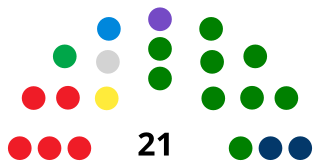
The regions of Italy are the first-level administrative divisions of the Italian Republic, constituting its second NUTS administrative level. There are twenty regions, five of which have higher autonomy than the rest. Under the Constitution of Italy, each region is an autonomous entity with defined powers. With the exception of the Aosta Valley and Friuli Venezia Giulia, each region is divided into a number of provinces.
A regional council in Italy is the elected legislative assembly of a region of Italy. In Emilia-Romagna and Sicily, the legislative bodies are called the Legislative Assembly of Emilia-Romagna and the Sicilian Regional Assembly, officially nicknamed as Sicilian Parliament, respectively.

The Politics of Basilicata, takes place in a framework of a presidential representative democracy, whereby the President of Regional Government is the head of government, and of a pluriform multi-party system. Executive power is exercised by the Regional Government. Legislative power is vested in both the government and the Regional Council.

The Politics of Calabria, Italy takes place in a framework of a presidential representative democracy, whereby the President of Regional Government is the head of government, and of a pluriform multi-party system. Executive power is exercised by the Regional Government. Legislative power is vested in both the government and the Regional Council.

The Politics of Lazio, Italy takes place in a framework of a presidential representative democracy, whereby the President of Regional Government is the head of government, and of a pluriform multi-party system. Executive power is exercised by the Regional Government. Legislative power is vested in both the government and the Regional Council.

The Politics of Lombardy, Italy, takes place in a framework of a semi-presidential representative democracy, whereby the President of the Region is the head of government, and of a pluriform multi-party system. Legislative power is vested in the Regional Council of Lombardy, while executive power is exercised by the Regional Government led by the President, who is directly elected by the people. The current Statute, which regulates the functioning of the regional institutions, has been in force since 2008.

The Politics of Piedmont, Italy takes place in a framework of a presidential representative democracy, whereby the President of Regional Government is the head of government, and of a pluriform multi-party system. Executive power is exercised by the Regional Government. Legislative power is vested in both the government and the Regional Council.

The Politics of Abruzzo takes place in a framework of a presidential representative democracy, whereby the President of Regional Government is the head of government, and of a pluriform multi-party system. Executive power is exercised by the Regional Government. Legislative power is vested in both the government and the Regional Council.

The Politics of Campania takes place in a framework of a presidential representative democracy, whereby the President of Regional Government is the head of government, and of a pluriform multi-party system. Executive power is exercised by the Regional Government. Legislative power is vested in both the government and the Regional Council.

The Politics of Emilia-Romagna, Italy takes place in a framework of a presidential representative democracy, whereby the President of Regional Government is the head of government, and of a pluriform multi-party system. Executive power is exercised by the Regional Government. Legislative power is vested in both the government and the Legislative Assembly.

The politics of Tuscany, Italy take place in the framework of a semi-presidential representative democracy, whereby the President of the Region is the head of government, and of a pluriform multi-party system. Legislative power is vested in the Regional Council of Tuscany, while executive power is exercised by the Regional Government led by the President, who is directly elected by the people. The current Statute, which regulates the functioning of the regional institutions, has been in force since 2005.

The Politics of Liguria, Italy takes place in a framework of a presidential representative democracy, whereby the President of Regional Government is the head of government, and of a pluriform multi-party system. Executive power is exercised by the Regional Government. Legislative power is vested in both the government and the Regional Council.

The Politics of Marche, Italy takes place in a framework of a semi-presidential representative democracy, whereby the President of the Region is the head of government, and of a pluriform multi-party system. Legislative power is vested in the Regional Council, while executive power is exercised by the Regional Government led by the President, who is directly elected by the people. The current Statute, which regulates the functioning of the regional institutions, has been in force since 2004.

The Politics of Umbria, one of the 20 regions of Italy, takes place in a framework of a semi-presidential representative democracy, whereby the president of the region is the head of government, and of a pluriform multi-party system. Legislative power is vested in the Legislative Assembly of Umbria, while executive power is exercised by the Regional Cabinet led by the President, who is directly elected by the people. The current statute, which regulates the functioning of regional institutions, has been in force since 2005.

The Politics of Molise, Italy takes place in a framework of a presidential representative democracy, whereby the president of regional government is the head of government, and of a pluriform multi-party system. Executive power is exercised by the regional government. Legislative power is vested in both the government and the Regional Council.

The Emilia-Romagna regional election of 1995 took place on 23 April 1995.

The Regional Council of Lombardy is the legislative assembly of Lombardy, Italy.

The Legislative Assembly of Marche is the legislative assembly of Marche. Founded as "Regional Council of Marche", it changed its name into "Legislative Assembly" in 2004.

The Legislative Assembly of Umbria is the parliament of Umbria.

Katia Tarasconi is an Italian politician, Mayor of Piacenza since 2022.





















